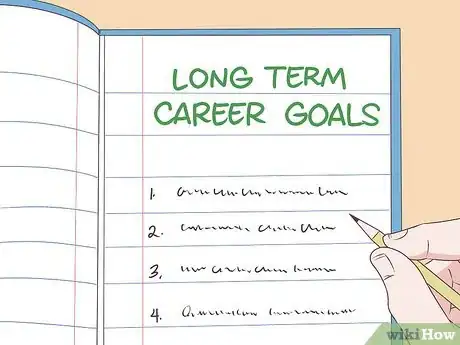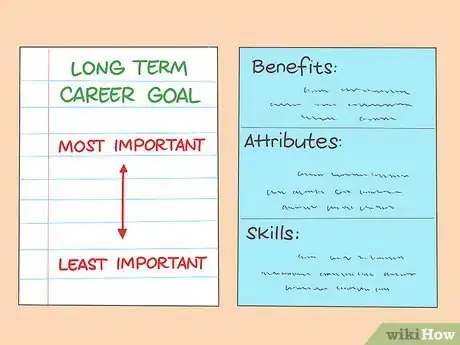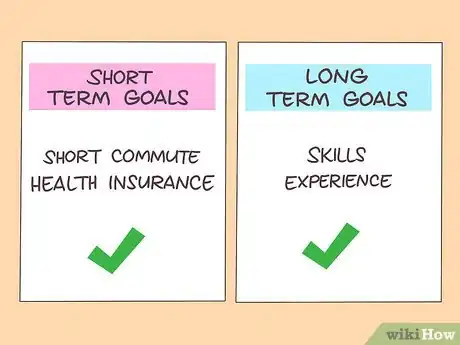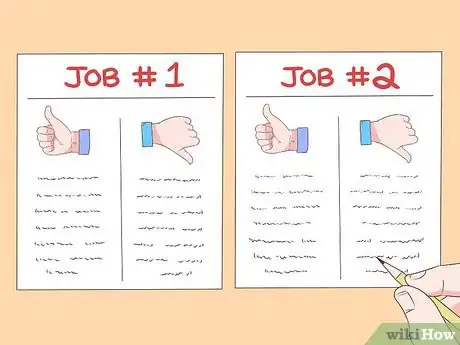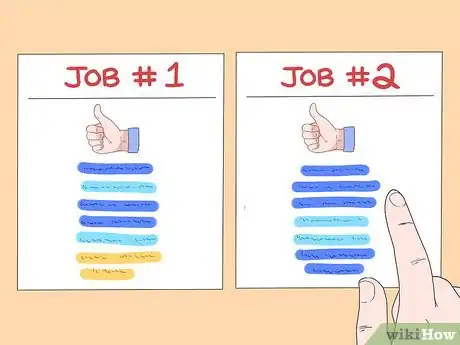This article was co-authored by Meredith Walters, MBA. Meredith Walters is a Certified Career Coach who helps people develop the skills they need to find meaningful, fulfilling work. Meredith has over eight years of career and life coaching experience, including conducting training at Emory University's Goizueta School of Business and the US Peace Corps. She is a former Member of the Board of Directors of ICF-Georgia. She earned her coaching credentials from New Ventures West and a Master of Business Administration from the University of San Francisco.
There are 7 references cited in this article, which can be found at the bottom of the page.
This article has been viewed 22,027 times.
If you’re looking for a job, you might consider yourself lucky to end up with two very appealing job offers at once. However, you may find it nearly impossible to decide between the two offers. Fortunately, there are several criteria you can hone in on to make choosing between two job offers a much easier process.
Steps
Establishing Your Priorities
-
1Write out your long-term career goals. Whatever job you end up taking, you’ll want it to ultimately help you reach the goals you’ve set for yourself in the long term. Keep a list or “map” of these goals nearby and refer to it continually as you decide between the two offers.[1]
- For example, your long-term career goal may be to become the CEO of a major company. If this is your goal, then you’ll want to consider whether or not each of the jobs you’re considering helps you to eventually achieve that goal.
- Try to make goals as detailed as possible, as this will make it easier to figure out how to work towards them in a concrete way. For instance, if you want to be a CEO, write down the specific industry, or if possible the actual company, you want to work in.
-
2Make a list of benefits and attributes you want your next job to have. In addition to your long-term career goals, you should also consider what you want out of your next job in the short term. Write down the different perks, benefits, and skills you want to receive from your next job and weigh them against your long-term goals in your considerations.[2]
- When you create your list of short-term goals, put them in hierarchical order from most important to least and decide which ones aren’t completely necessary. For instance, if one job offer includes a spacious office with a window, while this is certainly a perk, it may not rank very high on your list of priorities and thus shouldn’t count for much in your decision.
Advertisement -
3Balance your short-term goals with your long-term plans. You may have short-term goals you want your next job to accomplish, such as just having a source of income, but you should also keep your long-term plans in mind as you try to decide between two job offers. Ideally, you’ll want to choose the job that offers you perks, benefits, and experiences that also help you to achieve your goals in the long run.[3]
- For example, if your goal is to eventually become a high-level manager of a company, choose the job that gives you some of your short-term goals (e.g., a short commute, decent health insurance) while also giving you the skills and experience you can use to achieve your long-term goals.
- When considering job offers, always ask yourself what opportunities for growth or moving up in an organization each job offers you. These may not seem relevant in the short term, but they’ll be very important in the long run.
-
4Establish what your dealbreakers are. Part of establishing your priorities when looking for a job also involves knowing what aspects your next job absolutely has to have or not have. Make a checklist of these dealbreakers and use it to see if either job offer fails to live up to your requirements.[4]
- For example, you may require a certain level of compensation and consider any lower amount to be a dealbreaker.
- Be as reasonable as possible when coming up with your dealbreakers. It’s important to know the difference between what you absolutely require and what you badly want.
Determining a Company’s Culture
-
1Visit each company to get a sense of their respective workspaces. Whichever job offer you decide to take, you’ll probably end up spending a lot of time in that company’s workspace. Ask to visit the location where you’d be working for each company and take notes on what the space is like to gauge how you might feel about working there.[5]
- For example, note how much space each employee is given if they’re placed in cubicles or offices, whether each office has a window with a view, what sort of amenities are offered, etc.
- Make a list of the specific features you want your next workspace to have and bring it with you on your visit.
-
2Pay attention to how you feel about your potential colleagues. During your interview, take note of any “red flags” that stand out to you about how your potential boss or colleagues act. If their behavior or the company culture is off-putting to you, weigh the perks of the job against how working at the company would make you feel over time.[6]
- For example, if your potential boss is caustic and hard to get along with, imagine how it might feel to work under them for 8 hours every day. Know what your limits are and what you’re able to tolerate in a work environment.
EXPERT TIPMeredith Walters is a Certified Career Coach who helps people develop the skills they need to find meaningful, fulfilling work. Meredith has over eight years of career and life coaching experience, including conducting training at Emory University's Goizueta School of Business and the US Peace Corps. She is a former Member of the Board of Directors of ICF-Georgia. She earned her coaching credentials from New Ventures West and a Master of Business Administration from the University of San Francisco.Certified Career Coach
 Meredith Walters, MBA
Meredith Walters, MBA
Certified Career CoachOur Expert Agrees: When you're trying to decide whether to accept a job, think about the type of people you'll be working with and whether you think you'll work well with them. Also, consider the lengths of the projects, the type of feedback you'll be getting, and the management philosophy and culture.
-
3Research each company’s online presence. You often can tell a lot about a company’s culture by digging deep into their online activities and published material. Look for clues about each company’s culture on their websites and social media accounts.[7]
- For example, you may find that one company posts many pictures of employees on company holidays or festive events, indicating that that company cares a great deal about their employees’ happiness.
-
4Note how they treat you as an applicant. You’ll want to work for a company that has respect for you as a person, as well as respect for what your role in the company is. Pay attention to how courteous your potential managers are to you, how timely they respond to your emails and phone calls, and how they treat you during the interview process to get a sense of how they respect their (potential) employees.
Comparing and Contrasting the Job Offers
-
1Determine each job’s workload and whether it’s worth it to you. Make a side-by-side comparison of what each company will ask of you and what you’ll receive in return to get a better sense of which offer is more in line with your expectations and desires.[8]
- For example, if both jobs offer similar salaries and perks, but one involves a much longer commute and has a company culture that glorifies working lots of overtime, you may decide that that job offer is not going to give you the most return for your labor.
-
2Don’t be afraid to ask about extra perks and compensation in each job. Many companies offer additional perks to their employees that aren’t included in the standard salary and benefits package. Be willing to ask about these perks in your interview and take them into consideration when weighing the two offers next to each other.[9]
- Examples of such hidden perks include free museum passes, tickets to sporting events, and tuition reimbursement for university students.
- Although you should be willing to ask about these perks, do so in a tactful way. You don’t want to come across to your potential employer as caring only about money and benefits.
-
3Consider how each job would impact your career goals. Make predictions about where you’d be in 1, 5, and 10 years in each company. Note what new skills and experiences each job might bring you and whether you’ll be in a better position for achieving your long-term goals.[10]
- A good question to ask, both yourself and your potential employer, is what opportunities for growth does the job provide. Can you expect to earn a promotion in a reasonable amount of time? Will you become increasingly prepared to take on new responsibilities after each year in the job?
-
4Create a cumulative “pros and cons” chart for both job offers. Tally up all the benefits and downsides each job offer contains and place them on a board so you can look at them all at once. Externalizing the offers in this way will significantly help you to choose the best offer between the two.[11]
- If possible, make your chart so that the pros and cons can be shifted around and reorganized as you think through the offers. You may find that as you think through the offers further, some things you considered top priority may not matter that much to you.
-
5Organize your chart based on your priorities. When you have all the benefits and downsides of each job offer written out, organize them by order of priority, from absolutely essential to hardly important. This way, you can easily visualize which job offer is most in line with your goals and priorities.[12]
- For example, place all the benefits that help you accomplish your short-term and long-term goals at the top of the pros list; place those that only marginally help you accomplish your goals in the middle; and place those that don’t help you achieve your goals at all near the bottom.
- For a better visualization of the relative value of each job’s offerings, consider color-coding the pros and cons by significance. For instance, highlight all of the top pros in blue, the middle pros in light blue, and the low pros in yellow. Then, compare each job’s pros to see which one has more blue in it (and thus is a better offer).
-
6Choose the job you feel would be best for you. Finally, once you’ve tallied all the benefits and downsides of each job offer, make an informed decision based on the chart you’ve created. When making your choice, take your intuition into consideration as well; in other words, listen to your gut and choose the job you feel best about.[13]
References
- ↑ https://www.glassdoor.com/blog/choosing-between-2-job-offers/
- ↑ https://authenticjobs.com/8-factors-choosing-between-two-jobs/
- ↑ https://authenticjobs.com/8-factors-choosing-between-two-jobs/
- ↑ https://www.topresume.com/career-advice/how-to-choose-between-job-offers-the-essential-guide
- ↑ https://mashable.com/2017/08/28/how-to-choose-between-two-job-offers/#xw88E64sjmqR
- ↑ https://www.theladders.com/career-advice/choosing-between-two-job-offers
- ↑ https://www.topresume.com/career-advice/how-to-choose-between-job-offers-the-essential-guide
- ↑ https://www.monster.com/career-advice/article/how-to-choose-between-two-jobs-0517
- ↑ https://www.thebalancecareers.com/how-to-decide-between-two-job-offers-4154614
